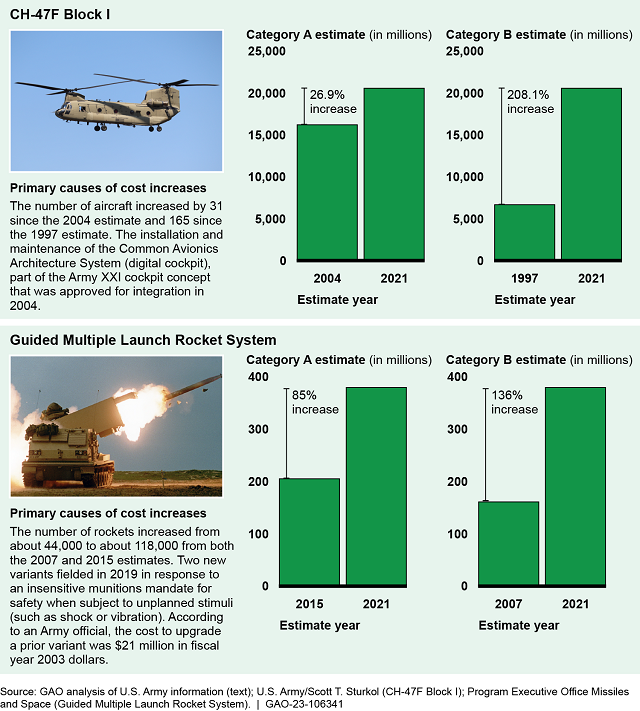Weapon System Sustainment: The Army and Air Force Conducted Reviews and the Army Identified Operating and Support Cost Growth
Fast Facts
DOD spends billions of dollars a year to operate and maintain its weapon systems—such as aircraft or ships—to ensure it can meet the military's needs today and in the future. These "sustainment" costs—expenses for repairs, for example—account for approximately 70% of a weapon system's total cost. DOD reports to Congress on these costs annually.
We looked at DOD's FY 2021 sustainment reviews and found that:
- The Air Force reviewed 9 weapon systems
- The Army reviewed 4 weapon systems and found that 2 were getting more expensive than anticipated
- The Navy didn't submit any reviews for FY 2021, but focused on planning for its FY 2022 reviews
Army's Guided Multiple Launch Rocket Weapon System

Highlights
What GAO Found
For fiscal year 2021, the Army and Air Force submitted to congressional committees sustainment reviews that quantified operating and support (O&S) costs for 13 weapon systems. The Army identified two systems with critical O&S cost growth, and the Navy did not submit any reviews. O&S costs—comprised of costs for repair parts, maintenance activities, contract services, and personnel operating and maintaining the system—historically account for approximately 70 percent of a weapon system's total life-cycle cost (details below).
- The Army submitted sustainment reviews of four weapon systems and developed independent cost estimates. The Army identified two weapon systems—CH-47F Block I and Guided Multiple Launch Rocket System—that experienced critical O&S cost growth. A statute defines critical O&S cost growth as at least 25 percent more than the estimate documented in the most recent independent cost estimate for the system (Category A); or at least 50 percent more than the estimate documented in the original baseline cost estimate for the system (Category B).
- The Air Force submitted sustainment reviews of nine weapon systems and developed independent cost estimates. However, the Air Force was only able to assess partially one of these weapon systems for critical O&S cost growth. The remainder of the systems did not have existing independent cost estimates generally due to the lack of requirements for such cost estimates at the time when the system was developed and procured.
- The Navy did not submit any sustainment reviews to Congress for fiscal year 2021. Rather, the Navy focused its efforts on developing guidance and schedules for its reviews in fiscal year 2022.
Amount and Causes of Cost Growth for Army Systems

Note: The sustainment review statute defines critical operating and support (O&S) cost growth as O&S cost growth of (a) at least 25 percent more than the estimate documented in the most recent independent cost estimate for the system; or (b) at least 50 percent more than the estimate documented in the original baseline cost estimate for the system. 10 U.S.C. § 4323(e)(2). For the purposes of this report, we refer to these categories of critical cost growth as “Category A” and “Category B.”
To support the military departments' efforts in conducting the sustainment reviews, both the Under Secretary of Defense for Acquisition and Sustainment and Cost Assessment and Program Evaluation (CAPE) issued sustainment review guidance. Additionally, CAPE identified lessons learned from the military departments' efforts to develop independent cost estimates to support the sustainment reviews. CAPE identified that both the Air Force and Army independent cost estimates submitted as part of their fiscal year 2021 sustainment reviews needed to better capture the details of all support costs associated with the weapon system. According to CAPE officials, CAPE began working with the Army and Air Force departments to ensure they address the issues CAPE identified in future sustainment reviews and associated independent cost estimates. Officials from the Air Force and Army agreed this was a shortcoming and said they were working with CAPE to address the issue.
Why GAO Did This Study
Section 802 of the William M. (Mac) Thornberry National Defense Authorization Act for Fiscal Year 2021 included a provision for GAO to review sustainment reviews conducted by the Department of Defense (DOD) and submitted to Congress on an annual basis through 2025. Specifically, the provision requires that GAO annually select 10 covered systems for which a sustainment review has been submitted and assess the military departments' efforts to quantify and address critical O&S cost growth for those systems.
This report examines the extent to which the DOD: (1) developed weapon system sustainment reviews for fiscal year 2021 that quantified critical O&S cost growth and identified the causes of that growth, and (2) developed guidance for its fiscal year 2021 sustainment reviews and identified any lessons learned from conducting the fiscal year 2021 sustainment reviews. GAO reviewed guidance for conducting sustainment reviews, the sustainment reviews submitted to the congressional defense committees in 2021, and the independent cost estimates developed to support these sustainment reviews. GAO also interviewed cognizant DOD officials about the sustainment review guidance and process, the independent cost estimates and identified critical O&S cost growth, and lessons learned.
For more information, contact Diana Maurer at (202) 512-9627 or maurerd@gao.gov.
